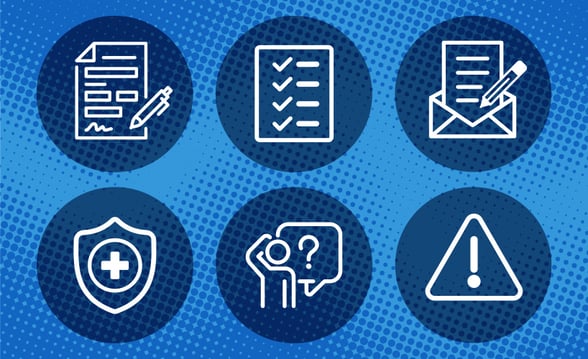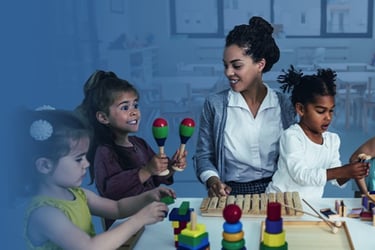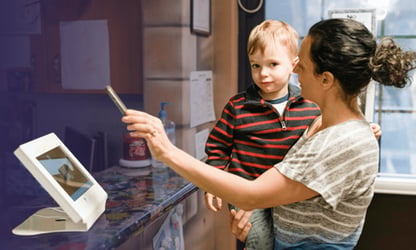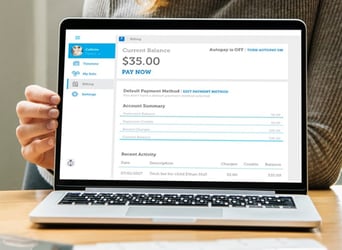
A play-based preschool creates space for kids to do what they do best: play purposefully. It’s not about keeping them busy; it’s about letting them explore, test ideas and figure things out in their own ways.
That’s where real early childhood education happens. Across the U.S., more schools are recognizing that worksheets don’t spark growth the way hands-on experiences do.
If you're in charge of a program, you’ve probably felt the tension between meeting learning goals and letting kids be kids. This shift toward play-based curricula is reshaping that balance — and yes, it makes preschool classroom management a little smoother.
Table of Contents
- The Science Behind Learning Through Play
- Core Components of an Effective Play-Based Curriculum
- Best Practices for Managing a Play Preschool Program
- Operational Tools to Support Play-Based Learning
- Case Studies of Successful Play Preschools
- How to Transition from Traditional to Play-Based Models
- FAQs
- 100+ Free Printable and Editable Templates for Preschools to Help Save Time!
The Science Behind Learning Through Play

If you’ve ever kept an eye on a group of preschoolers intensely focused on building a block city or assigning roles in an imaginary kitchen, you’ve seen learning at work, even if no one’s holding a pencil. That kind of focused, self-directed activity is what researchers are talking about when they talk about the power of play-based learning.
This research isn’t just a feel-good theory. The Harvard Center on the Developing Child highlights how play supports essential brain development, specifically the parts tied to memory, attention and emotional control. It’s one thing to memorize the alphabet; it’s another to apply it while creating a grocery store checkout system with a pretend scanner and hand-drawn price tags.
A 2022 study offers some good numbers behind this concept. Children involved in guided play, where adults gently shaped the experience without taking over, had stronger early math skills and knowledge of shapes than those who only had direct instruction. Yes, play outperformed more traditional teaching methods.
What about literacy? One experiment found that kids who learned letter sounds and rhyming through guided play scored higher on assessments than in structured lessons. The same study showed that a literacy-rich play approach helped boost storytelling and print awareness. In plain terms, the kids remembered more and told better stories when they had space to play.
The CDC also notes that play supports growth across social, emotional, motor and cognitive skills, which matters when considering the complete picture of a child’s development. It’s not just about preparing them for kindergarten, but for life.
You might be surprised how often child development activities don’t look like learning at first glance. That’s part of the magic. However, if you’ve worked in a play preschool or are considering running one, you know data and plenty of messes back the magic. Cleanup time might be the most underrated aspect of classroom management in preschool learning through play.
Core Components of an Effective Play-Based Curriculum
If you’ve ever observed a group of preschoolers turn a pile of cardboard boxes into a spaceship, a grocery store and a bear cave, all in the same morning, you already know that play is serious business. In a well-designed play preschool, those everyday moments aren’t just adorable. They’re the foundation of real learning.
A strong play-based curriculum doesn’t rely on chance. It’s thoughtfully built around the way young children grow. That means giving them freedom and structure, guiding their learning without taking the reins and planning activities that meet them right where they are developmentally, without overcomplicating things.
Structured vs. Unstructured Play
Structured play lets you gently steer kids toward specific skills, like recognizing patterns or using scissors safely, for example:
- A color-sorting activity
- A matching game
- A group movement song
These are the kinds of activities that quietly build toward those long-term early learning outcomes every program needs to track.
Unstructured play is where children’s personalities and problem-solving skills show up. It’s their world, their rules (mostly), and this freedom matters. It’s not chaotic; it’s creative.
When a child turns a box into a spaceship or Play-Doh into a bakery, they build social skills, emotional control and confidence. These moments are just as crucial as any curriculum checklist.
Role of Teachers in Facilitating Play
Here’s the truth: you can’t just set out some blocks and hope for the best. Teachers play a significant role in shaping the learning that happens during play.
Sometimes, that means asking just the right open-ended questions. Other times, it’s standing back and letting kids figure things out without jumping in too soon.
Being present without hovering is a fundamental skill. In many ways, you’re like the quiet anchor of the classroom, offering support, guiding when needed and trusting the kids to take the lead. This aspect is where your understanding of play-based learning matters. Your role isn’t to run the show, it’s to keep the show running.
Age-Appropriate Activity Planning
It’s essential to plan activities that make sense for your group’s age and stage. That doesn’t mean reinventing the wheel. It means knowing that 3-year-olds might be learning to share a glue stick while 5-year-olds are ready to design a city with blocks and signs.
Using hands-on child development activities makes it easy to introduce complex ideas in simple, playful ways. Want to sneak in some science, technology, engineering and math (STEM)? Try building ramps or experimenting with water. Want to work on emotional skills? Role-play a visit to the doctor’s office. It doesn’t have to be fancy, just thoughtful.
The beauty of a play-based preschool is that learning happens even when it doesn’t look like it. And that’s the point. It’s not about making every moment productive, it’s about making every moment matter.
Best Practices for Managing a Play Preschool Program
There’s something gratifying about running a play preschool. You’re not just creating a space where kids learn; you're shaping how they experience early childhood. That’s no small task.
It's equal parts planning, patience and being okay with the fact that your shoes might be covered by glitter by lunchtime. A strong foundation in managing your program makes all the difference for your kids and your sanity.
Classroom Setup for Optimal Play Zones
A classroom that encourages meaningful play doesn't just happen by pushing furniture around until it feels “open enough.” You need thoughtful zones that help kids transition smoothly from building towers to playing chef and then maybe to staring at a bug for 10 minutes like it’s the most interesting thing in the world.
Well-designed spaces allow kids to explore while helping staff keep everything under control (or at least looking like it). A cozy book nook, a defined sensory area and plenty of movement space can do wonders.
If you're looking for layout ideas that work in real-life classrooms, not just Pinterest-perfect ones, this classroom setup guide is worth checking out.
Daily Schedule Templates
Every playing preschool needs structure, even if that structure includes a solid half-hour of enthusiastic dinosaur impersonations. Having a reliable daily flow keeps your staff coordinated and your preschoolers from melting down when snacks don’t arrive on time.
Consistency helps children feel secure and gives teachers a precise rhythm to follow. Of course, you’ll always need to be flexible, especially when someone has a sock crisis during circle time, but templates can help you start on the right foot.
We keep a set of 100+ free daycare schedule templates on hand for just about every scenario, and they’ve saved us more than once.
Staff Training in Child-Led Learning Techniques
If you’re running a play-based preschool, your team has to know how to step back without checking out. That’s a skill. Knowing when to let kids take the lead and when to guide them gently is a subtle art that makes all the difference in supporting early learning outcomes.
Your staff needs more than enthusiasm. They need training that aligns with the heart of your program: letting kids explore on their terms. When teachers get this balance right, you see it.
It’s not magic, but when your staff gets it right, you see those early learning outcomes show up in the smallest moments.
Safety Protocols in Play-Based Environments
Safety doesn’t have to ruin the fun; however, it has to be part of it. In a play-based learning setting, kids are:
- Moving
- Climbing
- Pouring
- Pretending
- Occasionally forgetting where their bodies end and someone else’s begins
That’s why strong safety protocols aren’t optional — they're essential. Everything from how you supervise water play to how you clean up art supplies adds up. We lean on this daycare safety checklist because it’s clear and thorough and saves us from forgetting the obvious on a busy Monday morning.
Operational Tools to Support Play-Based Learning
Running a preschool play takes more than a love for children and a knack for creativity. It takes systems, real ones. These help you keep things running while letting kids explore, imagine and occasionally glue macaroni to places macaroni shouldn’t be.
You’re here because you care about doing this right. That includes the behind-the-scenes work most people don’t realize happens when you're leading a play-based preschool. Let's walk through some child care center tools that can take a bit off your plate so you can spend more time doing what matters.
Management Software That Supports Curriculum Planning, Parent Communication and Enrollment
If you've ever had to update 15 parents about a schedule change, chase down immunization forms and find time to plan next week’s sensory bin setup in the same morning, you know the chaos is real. Management software doesn’t remove the challenges, but it does organize them in a manageable way.
With tools that streamline enrollment, centralize parent messages and help you track learning goals, you’ll get time to focus on your play-based curriculum. You know, the fun part. Plus, parents get a window into the day-to-day magic without you having to write a novel every night.
The right platform combines your communication, planning and records so your focus can return to the joy of early childhood education, not email chains and file folders.
See what this looks like in action with Vanco’s preschool management software.
Automating Compliance Reports
Compliance isn’t the most thrilling topic, but it's non-negotiable. If you’ve ever found yourself elbow-deep in licensing paperwork at 10:00 p.m., you know it’s also exhausting. Automating your reports doesn’t just save time; it protects your peace of mind.
With the proper setup, your attendance records, incident logs and staff certifications will pull into your reports. There will be no guesswork and no last-minute scrambles, just less stress and more time to focus on what makes your playing preschool special.
Plus, it helps ensure you use reliable childcare center tools that align with state and local requirements without turning your office into a paper museum.
Tools for Scheduling Staff and Activities

Planning staffing for a preschool built around exploration and movement is like assembling a puzzle that changes shape daily. Scheduling tools take that puzzle and give it precise edges. You’ll know who’s available, plus when and where they’re needed, with enough flexibility to keep things running. Vanco can help you achieve this.
In our experience, having a clear schedule that everyone can see and follow impacts preschool classroom management. There are fewer surprises, smoother transitions and a staff that doesn’t feel like they’re playing musical chairs with naptime duties.
These tools also make it easier to plan child development activities and group rotations without burning out your team, which should be a top priority.
A genuinely supportive learn-and-play preschool isn't just about what's happening in the classroom; it’s also about how well your systems are holding up behind the scenes. Investing in tools for play-based learning doesn’t mean you’re trading warmth for structure. It means you’re making space for both.

Case Studies of Successful Play Preschools
Boston’s Pre-K: Where Play Meets Purpose
You wouldn’t expect finger paints and building blocks to be linked to college enrollment, but Boston’s play preschool program says otherwise. A long-term study of around 4,000 kids found that those who attended pre-K had a 70% high school graduation rate, compared to 64% who didn’t.
That’s not a small bump; it’s the difference that shows up on resumes years later. Even more striking, 54% went on to college, compared to 46% in the control group. Clearly, something is clicking in those playful classrooms.
Boston’s model balances structure with play, using a play-based curriculum backed by literacy, math and social-emotional learning evidence. Teachers are well-qualified (BAs, and many with MAs), and the results go beyond academics.
Kids were less likely to face suspensions or end up in juvenile detention. That’s not flashy, but it's the outcome policymakers usually beg for.
Tulsa’s Quiet Revolution in Early Education
Tulsa’s pre-K didn’t just prepare kids for kindergarten; it prepared them for life. With about 61% of 4-year-olds enrolled, this play-based learning program is one of the largest in the country, and it’s been under the microscope for two decades.
The data? Kids who went through Tulsa’s pre-K took more advanced courses in high school and were more likely to graduate on time. They even showed higher voter registration. That’s right; learn-and-play preschool might’ve nudged individuals toward civic engagement. Third-grade data also showed better math scores and self-regulation skills.
How to Transition from Traditional to Play-Based Models
Switching from a traditional to a play preschool model might feel like a big leap, but it can lead to incredible growth for your staff and the children. We’ve seen directors face the challenge of moving away from structured lessons, and while it’s not always easy, it’s worth it.
Staff buy-in can be tricky, especially if they’re accustomed to the “old way” of doing things. But the good news is that the shift becomes easier when teachers see the magic of children engaging in learning on their own terms.
It’s all about showing them how powerful child development activities can be when they step back and allow kids to take the lead. Of course, it’s crucial to have open conversations and training to ease concerns.
Parents, too, will need reassurance. Sharing the benefits of play and how it fosters cognitive, emotional and social development can help them understand that the focus on play is far from a break from learning; it’s the foundation for all future learning.
Finally, monitor progress. Watch early learning outcomes and adjust as needed. It’s a journey, but with patience and clear communication, you'll get there.
FAQs
What is a play preschool, and how does it differ from traditional programs?
A play preschool centers on learning through exploration and creativity, unlike traditional programs with rigid schedules.
How does learning through play improve early childhood development?
Play-based learning fosters cognitive growth and emotional resilience, offering children tools to navigate the world.
What qualifications should staff have to implement a play-based curriculum?
Staff must be well-versed in child development and trained to support hands-on, child-led activities.
How can I manage daily activities in a play preschool effectively?
Manage your day with a balance of free play and structured activities that allow for exploration.
What role do parents play in supporting play-based learning?
Parents nurture learning by creating environments at home that encourage curiosity, creativity and open-ended play.
How do I measure developmental outcomes in a play-based environment?
Observe children's interactions and growth in key areas like social skills, problem-solving and emotional development.
Are there compliance or licensing concerns with play-based curriculums?
Ensure your program aligns with state regulations, focusing on safety and educational standards for children.
What tools can help streamline operations in a play preschool?
Daycare administration software can simplify communication, scheduling and compliance, giving you more time for play.
How can I train my team in play-based education methods?
Training should empower staff to facilitate meaningful, child-centered activities, encouraging creativity and independence.
What are the first steps in transitioning to a play preschool model?
Start by shifting to a child-led curriculum, educating staff and communicating changes clearly to parents.
100+ Editable and Printable Templates to Make Preschool Easier
Play is more than just fun; it’s how children learn best. In a play preschool, every block stacked and every story acted out is part of a larger learning journey.
With Vanco’s daycare administration software and over 100 free templates, you can free up precious time and focus on what truly matters: building a creative, play-based learning environment.
Get the Full Collection with Just 4 Simple Steps: Assembly Required (0 Minutes)
Step 1: Click button
Step 2: Download 100+ ready-to-use templates
Step 3: Implement immediately
Step 4: Experience efficient childcare management











